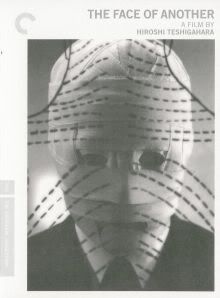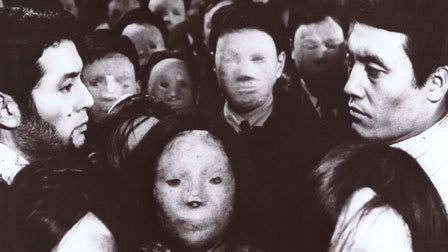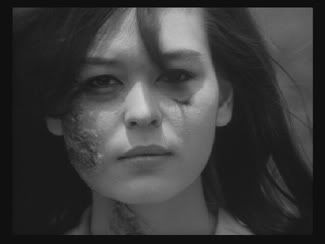The Face of Another

Title: The Face of Another (Tanin No Kao)
Rating: 3.5/5
Genre: (Sci-Fi), Psychological Drama
Starring: Tatsuya Nakadai
Director: Hiroshi Teshigahara
Author: Kôbô Abe
Language: Japanese
Release Date: 1966
Preface: A marriage between a philosophical poet and an experimental surrealist film maker, it is this combination that saw them release three thought provoking films across the span of four years, atmospheric and daring in their willing to push the boundaries of conventional cinema into avant-garde.
 It is through the eyes of a desperate man and his curious psychiatrist that we observe the ultimate dangers of true anonymity, allowing for a fearlessness and assertive manner as a result of the complete absence of repercussion, the subject matter whilst abstract by modern terms no longer feels entirely ‘sci-fi,’ since the advent of the internet and its widespread commercial use, and particularly the anonymity it provides, the subject feels more relevant now than I expect it did over forty years ago. Demonstrating the paranoid and ultimately self-destructive behaviour, it predicts the death of all human morality, and given how many of his other character observations have since come true, it feels like a genuine scenario for the near future.
It is through the eyes of a desperate man and his curious psychiatrist that we observe the ultimate dangers of true anonymity, allowing for a fearlessness and assertive manner as a result of the complete absence of repercussion, the subject matter whilst abstract by modern terms no longer feels entirely ‘sci-fi,’ since the advent of the internet and its widespread commercial use, and particularly the anonymity it provides, the subject feels more relevant now than I expect it did over forty years ago. Demonstrating the paranoid and ultimately self-destructive behaviour, it predicts the death of all human morality, and given how many of his other character observations have since come true, it feels like a genuine scenario for the near future.It is the legendary ‘Nakadai,’ known for his work with Kurosawa (Kagemusha, Ran), that takes the lead role, following a horrific accident that leaves his face irreparably scarred he is forced to hide his disfigurement. For a good portion of the film we fail to see the face of the lead character, shrouded in bandages, watching the disdain and distrust he faces in the presence of others; the audience too feels an odd disconnect, unable to identify any facial expressions we are left reliant on vocal expression adding to his shroud of mystery, simultaneously making his plight more difficult to empathise with yet easier to comprehend. Like Frankenstein’s monster, banished from society due to his unsightly appearance he returns to his mad scientist, not for his expertise but to creating a mask that will allow him to re-join the society that cast him out, but his new found anonymity transforms his character, gives him a freedom to do what he desires. Culminating in his dark plan to re-take his wife for himself, to seduce the woman incapable of looking beyond his disfigurement, once successful he becomes paranoid that she was too willing to look for love elsewhere, losing the last thing that he truly cared for.
 In addition to this a side-plot emerges, aptly demonstrating Japan’s post-war paranoia; the mental patients flurrying for cover for fear of an air raid but it is not these that have suffered the most. Centering around the young woman from Nagasaki, startlingly beautiful yet horrifically burnt on one side, as she carefully strokes her hair to disguise her disfigurement, we are allowed to painfully join the dots of her past and her continued torment that prevents her from living freely, hiding more than just an external wound. And yet, despite this fascinating mini-story within the grander picture, beyond a fleeting thematic link there is nothing linking the two plotlines, pieced together in a manner that takes us a moment to adjust to the new settings, overall acting detrimentally to the film. As a short additional complementary story this would have worked far better, or even some manner of combining this point he wanted to raise within the overarching main story rather than this muddled, randomly cut together result.
In addition to this a side-plot emerges, aptly demonstrating Japan’s post-war paranoia; the mental patients flurrying for cover for fear of an air raid but it is not these that have suffered the most. Centering around the young woman from Nagasaki, startlingly beautiful yet horrifically burnt on one side, as she carefully strokes her hair to disguise her disfigurement, we are allowed to painfully join the dots of her past and her continued torment that prevents her from living freely, hiding more than just an external wound. And yet, despite this fascinating mini-story within the grander picture, beyond a fleeting thematic link there is nothing linking the two plotlines, pieced together in a manner that takes us a moment to adjust to the new settings, overall acting detrimentally to the film. As a short additional complementary story this would have worked far better, or even some manner of combining this point he wanted to raise within the overarching main story rather than this muddled, randomly cut together result.The many scenes shot in absolute silence allow you to shut out all other senses and focus on the stark imagery presented, their minimalist manner evoking thoughts as to the characters development only to find ourselves suddenly re-immersed in lavish music, creating a welcoming shock to the senses. The dialogue displays the author’s poetic abilities superbly, many lines simply beautiful in the thought that has gone into their phrasing and the subtitles detracting nothing from the impact of the suggestions gone into the words, and yet they remain one of its greatest flaws. The entire film reeks of pretentiousness; not without a point to make, but at no point will they make their meaning clear. Combine this with the overt metaphors placed wherever possible, from the hair immersed in water in the back of the scientists office (no idea) to the wife who spends her time polishing gems (using something rough to create something beautiful perhaps?), the result feels too obscure and confusing to really extrapolate the directors intention.

There is little question in my mind the capabilities of this pairing, the sheer potential for radical thought-provoking existential philosophizing, captured on film by a man able to think outside of the box to suit his purpose, and certainly for a film of this age the effects hold up startlingly well, brought to life through the actors over the limited capabilities of the era. There is a poetic style prevalent to this artistic vision, but unfortunately it stumbles on the – rather major – hurdle of coherency; there is simply too much pretentiousness, unnecessarily dressing up an already fascinating story, and trying to make known all the points there are to raise whilst never really addressing them properly. Certainly not a bad film by any means, and almost impossible to truly classify, it simply fails to live up to expectations.


Comments
Post a Comment